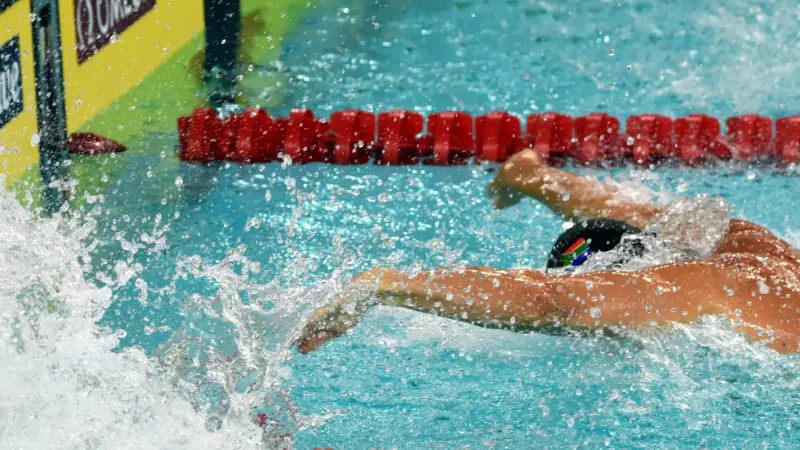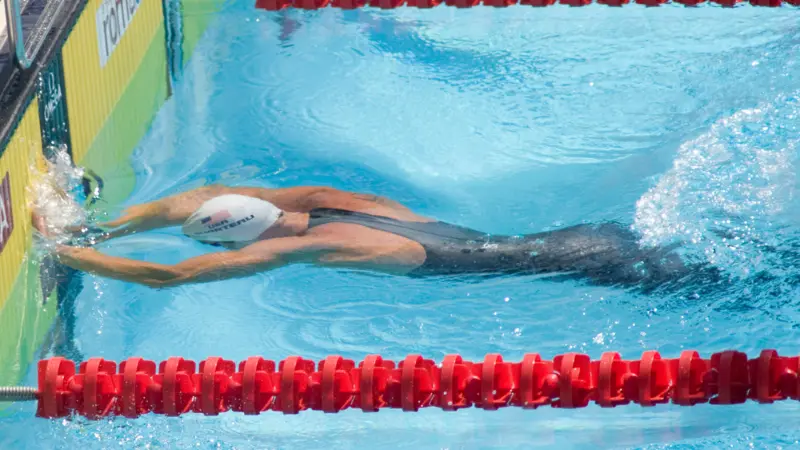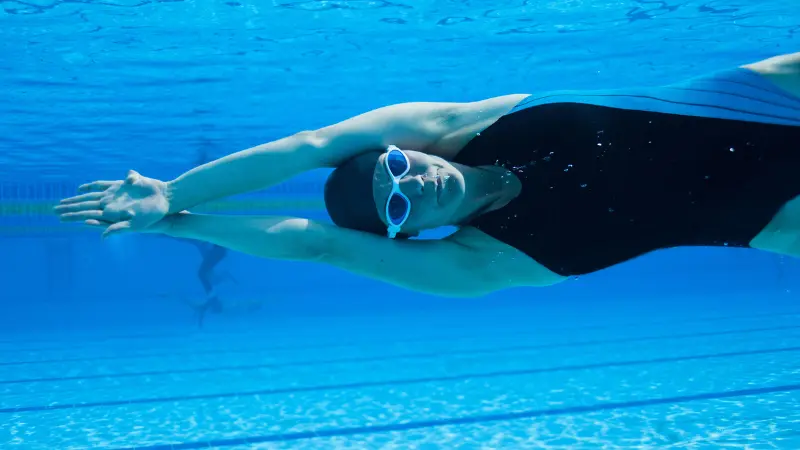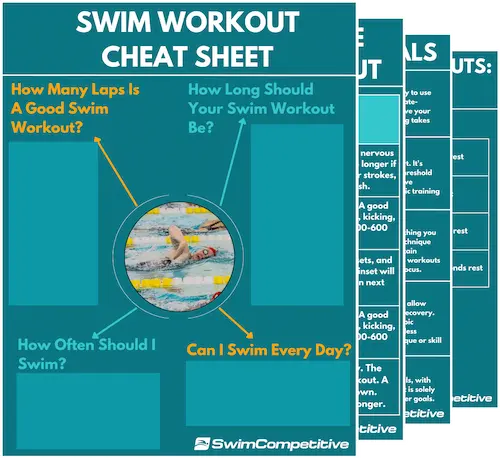No matter what kind of swimmer you are: competitive, masters, triathlete, or recreational… Knowing how to successfully complete an open turn is an important skill.
Whether you’re new to swimming and want to learn how to do an open turn or an elite swimmer looking to make your open turns quicker… There is always something you can work on to turn faster and more efficiently.
In this article, I’ll walk you through how to do an open turn with perfect technique, the critical phases of the turn, and provide tips and drills to ensure you can master it as fast as possible.
Which Strokes Use an Open Turn?
The open turn is used in butterfly and breaststroke. It’s also used in the individual medley when switching from butterfly to backstroke.
Initiating the Open Turn
Initiating the open turn consists of two phases, namely approaching the wall and setting up the correct body position on the wall. Let’s have a look at each-
Approaching the Wall for your Butterfly or Breaststroke Open Turn
The first step to perfecting your open turn is approaching the wall correctly.
Start by swimming butterfly or breaststroke into the wall and count how many strokes, from the t-mark on the floor, it takes you to comfortably get to there.
Practice this a few times at different speeds.
If you are swimming butterfly, remember not to breathe on your last stroke into the wall. Keeping your head down and in line will eliminate resistance and allow you to get to the wall faster.
Pro Tip: The more momentum you can carry into the wall, the more momentum you will be able to create, pushing off, resulting in a faster turn and breakout.
Once you have that down, you can focus on your last full stroke into the wall.
When you take your last stroke, butterfly, or breaststroke, you should be about half a body length away from the wall.

Body Position on the Wall
Extend your arms out in front of you and reach for the wall. The key is to have your head down and arms out with a straight bodyline. Again, creating the least amount of resistance and drag.
Being in a straight bodyline is crucial in case you are too far away from the wall after your last full stroke since it will allow you to glide and carry your speed and momentum through the water and into the wall.
After all, being in a streamlined position is the quickest way to move through the water!
Open turn drill recommendation: A drill that will help you become more aware of how your bodyline affects your swimming is simply practicing your push-offs but with no dolphin kicks. Practice getting a good push-off and holding your bodyline so you can glide as far as possible. Grab a few teammates and make it a competition! Focus on having straight arms, a braced core, your head down, and pointed toes.
After practicing your approach, note that you must simultaneously touch the wall with two hands.
This is a common reason for disqualification, so be very adamant about practicing this. You want to touch the wall with your fingertips approximately shoulder-width apart.
Try not to grab the wall, as this will encourage you to pull yourself up and towards it rather than focusing on bouncing off as fast as possible.
To do this, you want to stay low in the water when executing an open turn.

Knee Drive and Elbow Movement In The Open Turn
The open turn is essentially two moving parts happening simultaneously– the knee drive and the elbow movement. Don’t worry, I am going to explain each part separately and break it down for you!
Using The Knee Drive To Carry Momentum in the Open Turn
Part one is the knee drive. This is one of the most critical aspects of an effective open turn.
The purpose of the knee drive is to help us carry our momentum throughout the turn and switch directions quickly.
Once your fingertips hit the wall, immediately drive your knees towards your chest, placing your feet on the wall.
The quicker you get your knees up to your chest, the more power you will generate to turn your body around and push off in the opposite direction.
Working on your core strength can also help you drive speed through the turn better by helping you to pull your knees to your chest faster.
Another tip for faster turns is to incorporate some stretches, ensuring you are flexible and have the required mobility to perform fast turns.
Open Turn Drill recommendation: The backward flip turn. Find a spot in the middle of the pool and float with your face down. Float for 3-5 seconds, then drive your knees into a tight ball. If you do this movement quickly enough, you should complete a 360˚ summersault. Play around and see how much power you can generate to propel you into a summersault(s). How many summersaults can you do in a row? Get competitive with your teammates! This drill will show how being tight and compact can help us switch directions in the water.
You should end in a ball-like position. The more compact you are with this movement, the more speed and power will be transferred.
Here is a quick video explaining the importance of the knee drive in the open turn:
Do You Want to Make Every Lap Count?
Stop wasting your time in the pool feeling lost and doing directionless swim workouts, and start training effectively! Our ebook contains 97 structured and goal-orientated swim workouts to help you become a better, faster, and fitter swimmer. Whether you’re a complete beginner or a seasoned pro, there are a multitude of workouts for every type of swimmer.
Open Turn Arm Movement
Part two of the open turn is the elbow movement or the ‘elbow your brother and call your mother’ drill.
The purpose of the elbow movement is to help keep your bodyline as straight as possible and set you up for a good push-off.
After your knees are up and your feet have landed on the black T on the wall, one of your elbows (whichever side is most comfortable for you) will drive back as if you are ‘elbowing your brother’ behind you.
This motion will lean you back and have you facing upwards towards the surface of the water.
At this point in the turn, streamline is the goal. With the arm, you drove back, straighten and extend so that it’s pointing towards the other end of the pool.
With your hand still on the wall, let go with a bent 90-degree elbow and enter the water right behind your ear like you are ‘calling your mother.’
After this, your hands lock together, and you go into a streamline position.
Here is a quick video of what this looks like:
Streamline and Feet Placement for the Open Turn
When preparing for your push-off, you want to be in a tight streamline and have high feet placement on the wall.
Having high feet placement at about a 45-degree angle will help you push down into the water and set you up for effective underwater dolphin kicks.
If you place your feet too low, you could shoot toward the surface of the water and break out earlier than intended.
Note that a proper streamline consists of straight arms overhead, hands locked together, and ears tucked in between your biceps. Head, neck, and spine are in line!

The Push Off
A common mistake swimmers make when executing the open turn is rotating their bodies while still on the wall.
You want to avoid this as much as possible!
This can create drag and takes longer, making you slower.
Instead, try focusing on bouncing off the wall as quickly as possible. Then as you push off the wall, you rotate first onto your side and then your stomach.
The push-off is one of the phases where you move the fastest in the water, second after the dive. Therefore, you want to make sure that you really take advantage of it and don’t unnecessarily slow yourself down by having a poor streamline position.
Once you’ve pushed off and rotated onto your stomach, glide for a second or two before starting your dolphin kicks. This way, you are maximizing your speed off the walls.
Pro tip: Make sure that you are bouncing off the balls of your feet when pushing off. This is similar to a jumping movement outside of the water and is the most powerful way to push off.
For some additional visual explanations of the open turn, I recommend watching this video by Derek Maas, where he does an excellent breakdown of some common mistakes:
Be Patient When Learning to Open Turn
The open turn is a complex movement with many moving parts happening at once.
I recommend breaking down the process and practicing everything individually: the approach, the knee drive, the elbow movement, and the push-off.
Then try putting everything together. Before you know it (and with lots of repetition), your open turns will become muscle memory, and you’ll be flyin’ off those walls!





